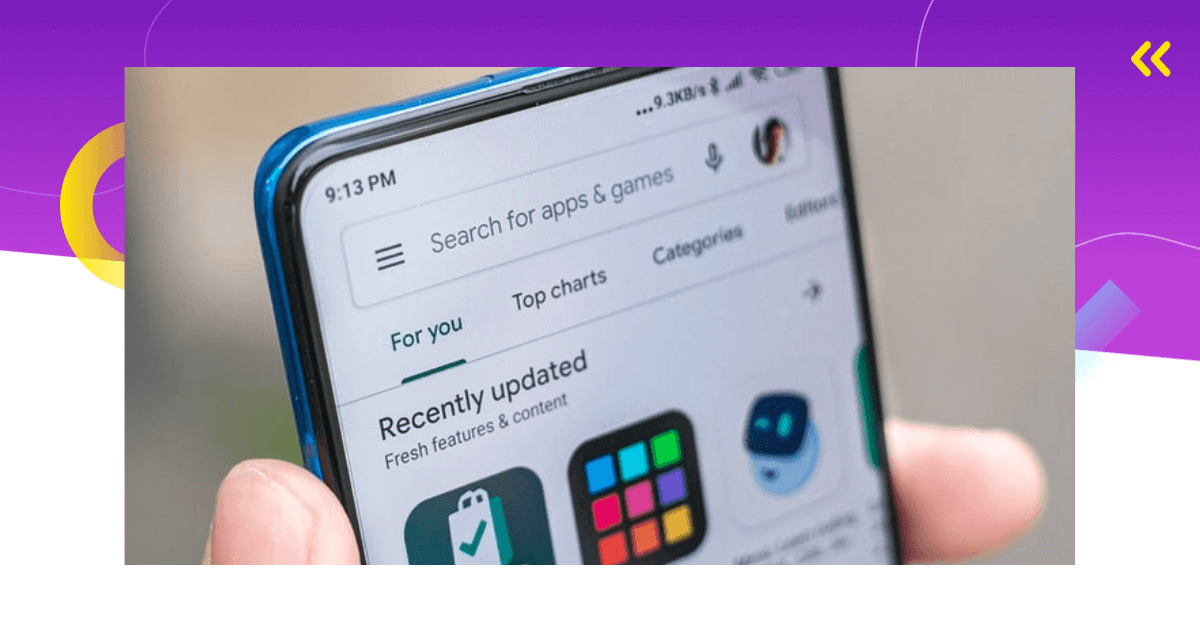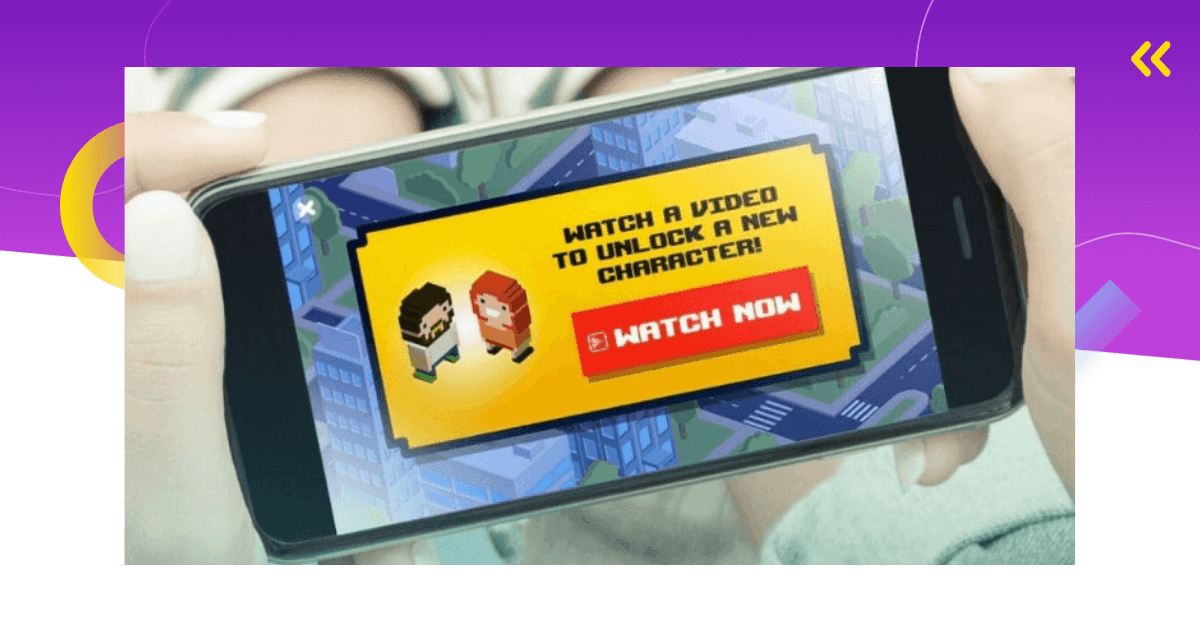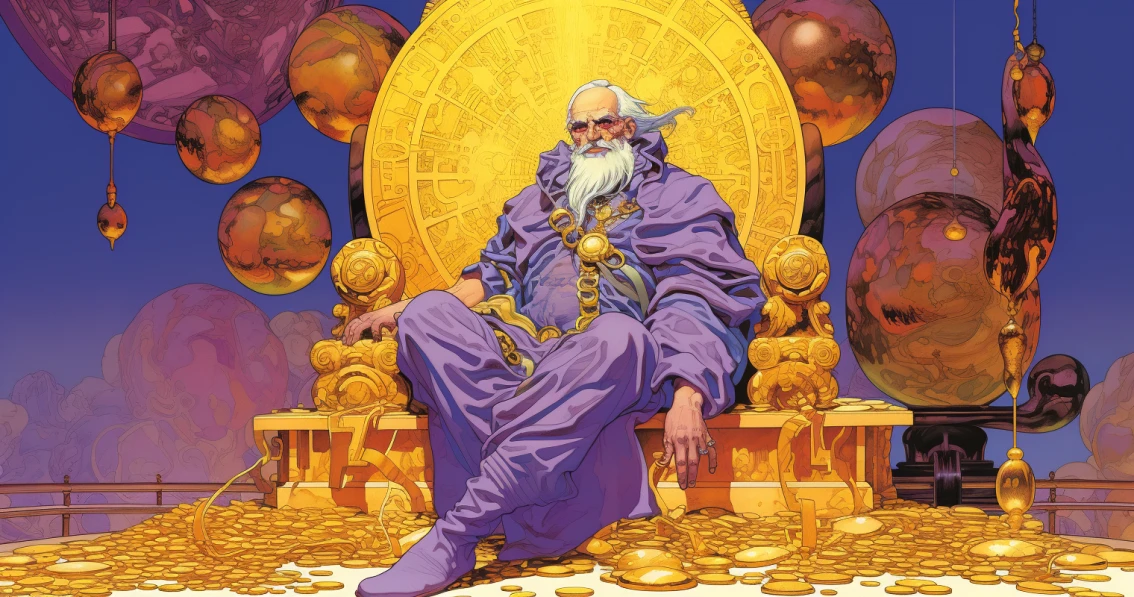In-app advertising is one of the biggest mobile game monetization trends in 2023. It is a great way for mobile game publishers to earn money off their games. However, in-game advertising revenue depends on the type of mobile game ad formats you choose.
That’s why I have put together an overview of the most important ad formats used in mobile game marketing. You’ll find out how each ad format works, and which one can bring you the most ad revenue.
As a bonus, I’m going to show you the real results of using different ad formats in mobile games.
So make sure to keep on reading.
5 Mobile Game Ad Formats for In-Game Advertising

1. Rewarded Video Ads
One of the most popular ad formats for mobile games are rewarded video ads.
Here’s how rewarded ads work, it’s quite simple.
The player gets a reward for watching an ad. The reward can be anything from coins and gems to points, extra lives, or other game content. That way users have a great incentive to view the ad. Most commonly, a rewarded ad is in video format.
Not only are rewarded video ads less obtrusive, but they’re actually desirable by players. According to Techcrunch, 68% of users like this ad format. This ad format is the least disruptive – only 24% of players find rewarded ads disruptive.
Advertisers benefit from rewarded video ads because they pay only if the player takes the desired action. Since the completion rate is very high, mobile game publishers can get high eCPMs. That ultimately increases their in-game advertising revenue.
This ad format is known for its high view rates and highly engaged players. On the flip side, there is a possibility that the players don’t even glance at the ad content but only wait for the loot.
It’s a win situation for developers, advertisers, and players.
According to IronSource, rewarded video ads can boost your ad revenue by 20% to 40%. eCPMs for rewarded ads can be anywhere from $10 to $50, which is high. Rewarded ads also increase lifetime value as well as user retention.
However, don’t get stuck on those numbers, there are many different factors that influence eCPMs of rewarded ads. Theory is one thing, so let’s see how rewarded video ads look like in action.
Boost Your Ad Revenue with Rewarded Video Ads
Rewarded video ads won’t work the same for everyone. It depends on what type of game you have, how well you integrated rewarded ads, and the way you set them up.
It’s important to think about how you’re going to monetize your mobile game before you even make it. That way you prepare everything in advance and can integrate ads seamlessly.
You also need to decide what type of rewards you want to offer to users. That largely depends on the game genre, as well as other monetization methods you might be using. For example, if you use a mix of in-app ads and in-app purchases, you need to balance the rewards players get from watching ads and the content you offer for purchase.
Another thing is setting up the frequency and length of rewarded ads. Moreover, setting up how many times the same ad can be shown to the users. All that plays a role in how well the ads integrate into your game and how much revenue you get from it.
Showing the same rewarded ad multiple times might increase brand recognition. That is a positive thing for the advertisers. But on the other hand, it might get boring for users to the point where they don’t want to watch it again.
It’s all about balance.
Some games use a strategy for rewarded ads where they’re not shown automatically, after certain events or triggers, but players need to manually access them. Hay Day is one of such games. It uses in-app advertising (along with in-app purchases) that focuses solely on rewarded ads.
But here’s the kicker.
The ads are so unobtrusive, you need to go and find them yourself. It comes in a form of a cinema ticket that can be accessed in the menu and players then watch a movie trailer, i.e., an ad. All of them are 30 seconds long. Furthermore, players can’t even access the rewarded ads before they reach level 10 and there’s a daily limit as to how many ads they can watch.
It’s an interesting monetization setup where rewarded ads are, in fact, very limited.

2. Interstitial Ads
Interstitial ads are full-screen ads that users can skip after watching them for a certain amount of time. This mobile game ad format can be static or more interactive (interstitial video ads).
According to IronSource, eCPMs for interstitial ads can go up to $20 (in tier 1 countries), while the average is $4-$6.
However, getting high eCPMs from interstitial ads depends on many different factors. Mobile game genre, platform, geographic locations, how well you integrate the ads, etc.
First of all, it’s important to set up the right time for interstitial ads to appear. For example, nobody wants to be interrupted in the middle of the game with an interstitial ad.
It is best to show them when the game naturally pauses or transitions. For instance, after a completed level. That way, the ad is not intrusive, and the user experience stays positive.
This type of ad can be static, but can also include rich media content such as animations. It is recommended to use interactive content that generally contributes to user engagement and ad memorability.

3. Playable Ads
One of the mobile game ad formats that are very popular right now is playable ads – they work particularly well for mobile games.
As users become more tired of irrelevant and intrusive ads, playable ads become a great alternative. According to SmartyAds, playable ads perform 8x better than interstitial ads.
Here’s how it works.
As you can guess from the name, playable ads are a type of ads users can play. Users tend to like them because they can try out a new app and engage with it before installing it.
This is great for advertisers because playable ads target high-quality users who would continue using the app after downloading it. It’s also what makes playable ads expensive.
CPI of a playable ad is much higher than that of rewarded or banner ads. That is great news for mobile game publishers who can use playable ads to increase their in-game advertising revenue.
There are 3 elements every playable game ad should contain:
- An introductory lead-in on how the game is played (tutorial)
- A short demo for the user to play the game (simplified gameplay)
- A CTA after the demo inviting the user to install the game
Example of a Playable Ad
Above, you can see an example of a top playable ad in the gaming category. It’s for Royal Match, a top-grossing match-3 puzzle game. The main goal of this playable ad is to get users hooked on solving match-3 puzzles, and of course, download Royal Match to continue playing.
What makes it so successful is that it nails the essential elements of a playable ad – tutorial, simplified gameplay, and CTA.
The tutorial at the beginning is extremely simple and even players who are not familiar with match-3 mechanics can quickly figure out what to do. Next, users get a taste of the gameplay and see the match-3 mechanics in action. After users complete the match-3 puzzle, there’s the option to download the game or retry.

4. Native Banner Ads
This is a common mobile game ad format. A banner ad is placed in a way so that it looks like it’s a part of natural game flow. Mobile game publishers use it because it’s unobtrusive and discrete.
Of course, it needs to be placed strategically so that it doesn’t interrupt the gameplay or cover an important part of the game. Usually, that means placing it in the corners. That way, a banner ad doesn’t hinder the user experience.
Some of the benefits of banner ads are low cost per click and how easy it is to produce them. However, an important thing to note is that the popularity of banner ads is dropping. Since players got used to seeing banners in the game, they might have developed a so-called “banner blindness”. The thing is, people don’t click on banner ads that often, which results in a low CTR.
This ad format simply can’t compete with rewarded or interstitial ads when it comes to revenue. Some even go so far as to say banner ads are dead.
It might work well in addition to other formats, but don’t think you’ll earn a ton of money solely through banner ads.

5. Offerwalls
This ad format is similar to rewarded ads. Just like rewarded video ads, it is opt-in, which means users choose to engage with it themselves.
It is based on users having to complete a task to receive a reward. Instead of getting a reward for watching an ad, the user must fill out a survey, play a mini-game or do a similar task.
Generally, offerwall ads work best if:
- The game features a virtual currency
- The offers align with the players’ interests
Offerwalls are a great fit for games that monetize with in-app purchases. In fact, according to ironSource, offerwall users are 10 to 14 times more likely to make IAPs.
Another benefit of offerwalls is that they can positively impact user retention. When it comes to offerwall users, their retention rates are 5 to 7 times higher than among other players (ironSource).
Finally, the biggest benefit of offerwalls are their eCPMs. The thing is, getting players to complete the actions from the list is nothing but easy. But those players that do finish them are likely to be very valuable for the advertisers. Because of this, advertisers are willing to pay more money for them, which then results in higher eCPMs for offerwalls.
However, not everything about offerwalls is great.
A lot of players won’t engage with offerwalls. Usually because completing a task can be time-consuming, while the reward is too small. Oftentimes, it’s just not worth it to the users.
Because of that, many ad networks don’t support offerwalls as an ad format anymore. For this reason, the developers’ choices are limited. Some types of offerwalls were even banned on iOS. The main reason for this is using these ads to get the user to install another game, which conflicts with Apple’s policy.
Some of the ad networks that still offer this ad format are ironSource, Tapjoy, Chartboost, and Fyber.
Final Thoughts on Mobile Game Ad Formats
As we have learned, the ad formats you’re going to choose depends on the type of game you have as well as your monetization goals.
There is no secret formula that will work for everybody.
Now that you know all the mobile game ad formats that are relevant in 2022, you can test them and see what works best for your game.
Ideally, you should start thinking about monetization and ad formats while you’re designing the game. That way, you make sure you provide users with the best experience while maximizing your in-game advertising revenue.
Now we want to hear from you.
Which mobile game ad format worked best for you? Do you need help with choosing a mobile game ad format and increasing your ad revenue?
Let us know in the comments below!
Don’t forget to subscribe to our newsletter, we’ll keep you in the loop about all mobile game marketing trends.







Comments